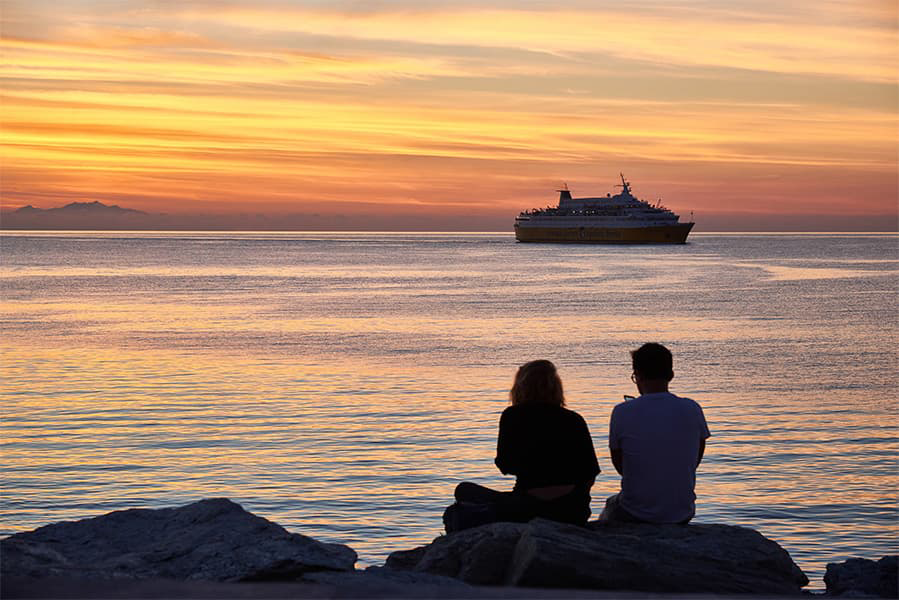Colonia del Sacramento - Buenos Aires
Ferries to Argentina
Colonia del Sacramento - Buenos Aires
Ferries to Argentina

The Colonia del Sacramento Buenos Aires ferry route connects Uruguay with Argentina and is currently operated by 2 ferry companies. The Buquebus service runs up to 3 times per day with a sailing duration of around 1 hour 15 minutes While the Colonia Express service runs up to 5 times per day with a duration from 1 hour 15 minutes.
So that’s a combined 56 sailings on offer per week on the Colonia del Sacramento Buenos Aires route between Uruguay and Argentina. Compare now and get the best fare at the time that you want to travel.
More routes than anyone else.

Compare fares, times & routes in one place.
Change plans easily with flexi tickets.

Book e-tickets & manage trips in-app.
Live ship tracking & real-time updates.

Top-rated customer support when you need it.
In the south-western of Uruguay, on the tip of a peninsula that points to the Argentinian capital of Buenos Aires on the opposite bank of the River Plate, is the small city of Colonia del Sacramento. It’s a settlement with a rich and varied history. Founded in the 17th Century by Portuguese colonists, Colonia del Sacramento can boast to be one of the oldest cities in the entire country with the curving lanes of the historic quarter clashing brilliantly with the downtown grid of modern streets. The port in Colonia del Sacramento is found on the southern coast of the city, just to one side of Honda beach. Here two wide concrete piers stretch into the great River Plate to form an artificial oblong bay. The ferry terminal is a large, modern facility that sits between the piers, inside which can be found toilets, an ATM, a shop selling souvenirs and an open-plan waiting room. Travelling to and from the port is easy due to Colonia del Sacramento’s prime location in the densely populated south-western region of Uruguay. The Route 1 highway, found just a few minutes from the entrance to the port, covers over a hundred miles of the coast enroute to the capital of Montevideo. The bus terminal by the harbour is ideal for those looking to travel more locally, with routes heading into the city centre and along the beach-lined promenades. Currently two operators offer passenger services from the port. Both Buquebus and Colonia Express ferries sail the short journey west across the expanse of the River Plate, crossing the border into Argentina to Buenos Aries a number of times each day.
The city of Buenos Aires, located on the western shores of the vast River Plate estuary, is the largest city and capital of Argentina. It’s a multicultural metropolis that has retained much of its historical European identity, evident in the downtown clash of architecture that ranges from the soaring towers of the central business district to the pink walls of the Italianate-style Casa Rosada presidential palace. The ferry port of Buenos Aires is found to the north of the main collection of piers and shipping yards found in the Retiro borough of the city. The terminal here is set along the grass-lined banks of the Lujan river that flows into the larger River Plate, just to one side of a large man-made marina. A waiting area can be found inside the building and a limited number of car-parking spaces are available along the road into the harbour . Just a few minutes’ walk from outside the port entrance is the Marina Nueva train station that offers routes deeper into the suburbs of Buenos Aires, including a stop by the city’s international airport on the coast. The extensive National Route 9 highway, just a few minutes’ drive from the port, cuts north and connects motorists to other major Argentinian cities including Rosario and Cordoba. Passenger routes run from the port multiple times throughout the week, serviced by Buquebus and Colonia Express ferries. Both these lines offer daily routes to the nearby capital of Montevideo in Uruguay, a short distant across the River Plate, and the smaller Uruguayan city of Colonia Del Sacramento. Colonia Express also sails to the port-town of Carmelo a number of times per day.